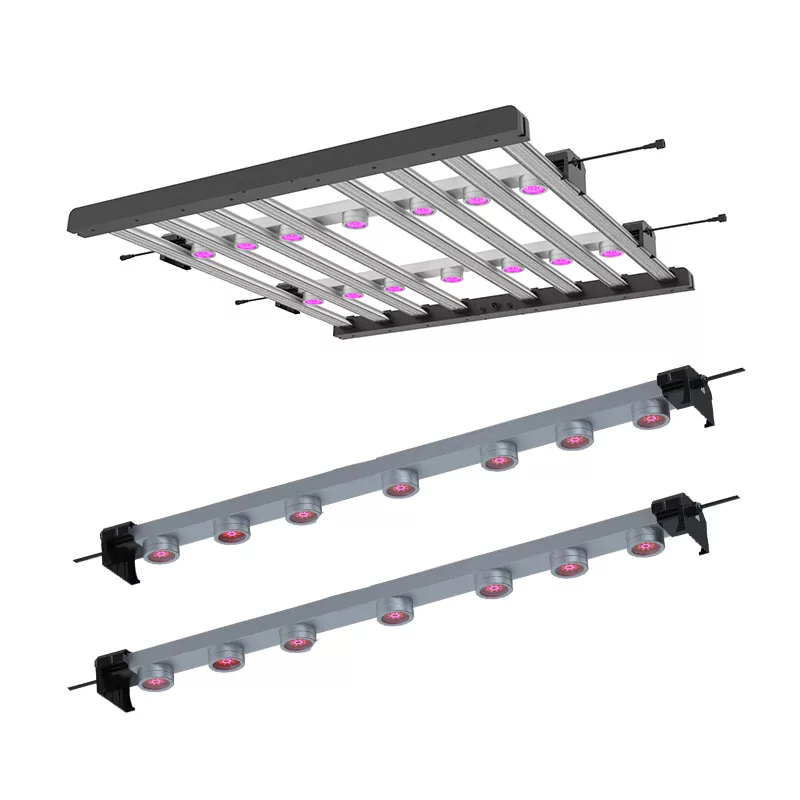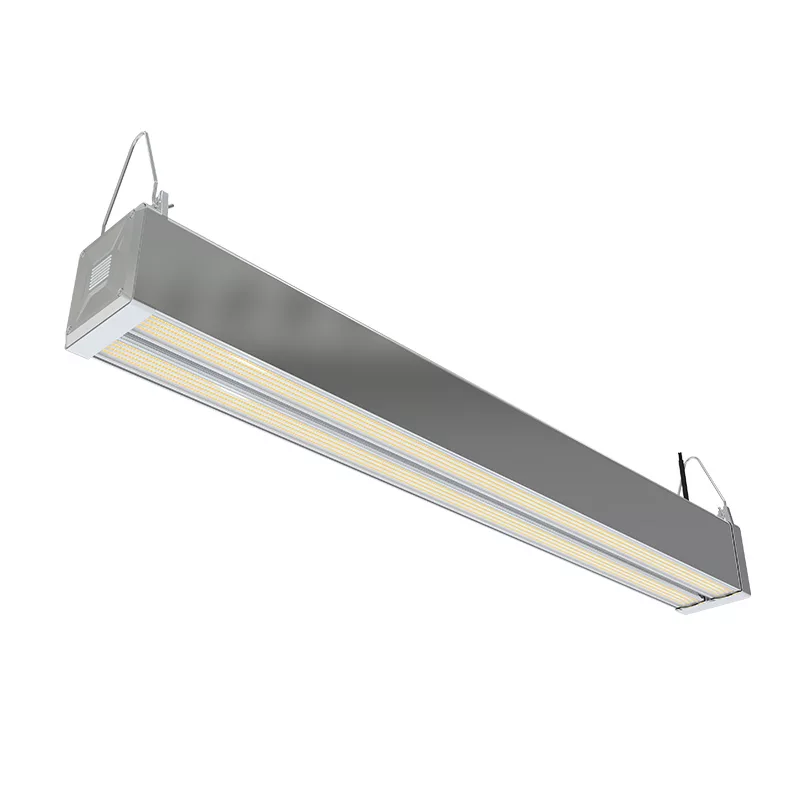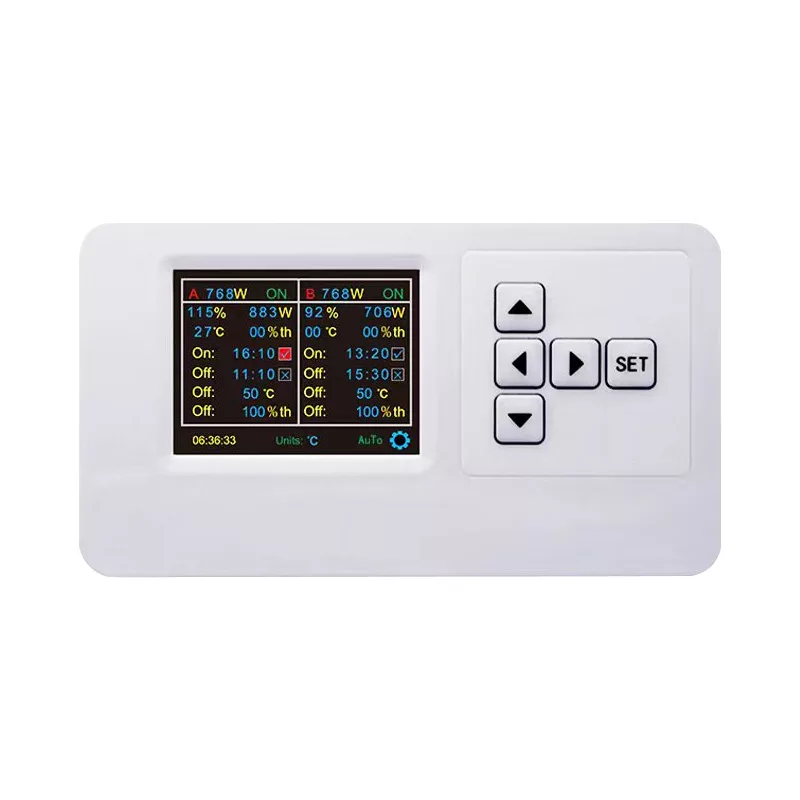Effects on plant growth and development
Plant growth is affected by various environmental factors, such as temperature, light, humidity, CO2 concentration, etc. Therefore, improving the growth environment of plants is conducive to increasing the growth rate of plants and the yield quality of their products and organs. Among all these factors, the light environment is the most basic and important environmental factor. Plants perceive changes in the external light environment through different photoreceptors (e.g., photosensitive pigments, blue light receptors, UV-B receptors, etc.). Photoreceptors play different roles in plant growth, and in different light environments, plant growth shows different growth states due to the differences in the role of photoreceptors. Plant photoreceptors sense changes in the light environment by sensing changes in light quality, light density, light duration and light angle, and regulate plant growth through signal transduction to adapt to different light environments.
Effect on plant morphology
Different spectral distributions had different effects on plant growth. Monochromatic red light significantly reduced the assimilation of CO2 in lily, resulting in lower growth indexes of bulbs. Red light also affected leaf expansion, dry matter accumulation and stem elongation. Tomato and cucumber seedlings accumulated more dry matter and expanded their leaves faster under red light. Tobacco, strawberry and lettuce leaves were larger under red light, and red light increased dry matter accumulation in parsnip seedlings, chili peppers, radish sprouts and grape shoots, while dry matter accumulation in wheat was lower under red light. Red light also affected plant stem elongation. Red light promoted stem elongation in melon and rice seedlings, but significantly inhibited stem elongation in tomato. Blue light had different effects on different plants, and blue light could affect the growth of plant leaves and stems. Under monochromatic blue light, marigold stems were the longest and significantly increased the leaf area of cucumber and tomato, but inhibited the growth of tobacco leaves.
Light density also has a great influence on plant growth. Yang Xingyou et al. showed that with the decrease of light density, the height of tobacco seedlings increased, and the dry-to-fresh ratio, stem thickness, leaf thickness and mass per unit of leaf area all showed a decreasing trend. Under low light, the lateral growth of autumn eggplant seedlings was weakened, the leaf blades became thinner, and the relative growth rate of seedlings was reduced; with the weakening of photosynthetic photon density, the leaf area of cherry became larger, the specific leaf weight decreased, and the leaf blades became thinner. The number of leaves of pepper seedlings under low light decreased, the height-to-thickness ratio increased, and the root-to-crown ratio, specific leaf freshness, dry sample mass whole plant dry sample mass and seedling strength index decreased. Wang Xuewen et al. found that the root-crown ratio of tomato seedlings decreased significantly under low light, i.e., the allocation of biological production of the plant flowed more to the stem and leaves, while the allocation to the roots decreased.
Impact on crop quality
Effect on sugar content of substances
Different light quality can affect the metabolism of plant sugars. Sugars are the main products of photosynthesis and the main source of energy for plants to maintain their life activities. The reason and mechanism of the influence of light quality on sugar content are not yet clear. On the one hand, light quality affects the absorption function of plants and thus changes the final sugar content; on the other hand, different spectral distributions can directly activate and induce the regulation of sucrose metabolizing enzymes by photosensitive pigments. Many studies have shown that red light can promote the accumulation of soluble sugars, sucrose and starch. In the studies of tomato, cabbage, parsnip seedlings, lettuce and other vegetables, it was found that red light favored the increase of soluble sugar content. In studies on land cotton, radish sprouts and rice, red light was found to promote soluble sugars, starch content and starch accumulation. It has also been reported that blue light increases the sugar content in the cells of carnation, pinto and cyanobacteria. The combination of red and blue light usually favors sugar synthesis as well.
The soluble sugar content of tomato leaves and rice seedlings was higher under combined red and blue light. Light density is closely related to sugar metabolism. BaoSiWei et al. found that high light density favored the accumulation of primary metabolites such as soluble sugars and starch in the leaves of Picea abies, while low light density inhibited the production and accumulation of primary metabolites. Hou Xingliang et al. showed that the soluble sugar content of tomato seedling leaves decreased under low light density.
Effect on plant vitamin C content
Vitamin C is an essential nutrient for human health. Studies have shown that blue light can promote vitamin C synthesis. The vitamin C content of pea seedlings, radish sprouts, strawberries and green garlic seedlings was higher under blue light treatment. A suitable ratio of blue to red light is also effective in increasing the vitamin C content of plants. Studies on oilseed rape found that the vitamin C content of leaves of group-cultivated seedlings was maximized under blue-red 3:1 treatment, while studies on lettuce found that blue light and red-blue 1:1 light significantly increased the vitamin C content of young lettuce. It was also found that red light could increase the vitamin C content of tomato, cucumber and strawberry fruits, and both red and blue light could increase the vitamin C content of colored bell peppers.Toled found that spinach leaves contained higher vitamin C content under white light, which promoted the photosynthetic capacity of spinach, increased the content of glucose, and facilitated the increase of vitamin C. The results showed that the photosynthetic capacity of spinach was increased under white light.
TUBU LED Grow Light Manufacturer Products
Effects on photosynthetic pigment content in leaves
Different spectral energies had different effects on the photosynthetic pigment contents of plant leaves. Red light was able to affect chlorophyll synthesis, and the chlorophyll contents of strawberry, tomato, chrysanthemum, cucumber and dwarf cowpea were highest under red light. Red light treatment increased the chlorophyll a, chlorophyll b and total chlorophyll contents of plant leaves. Blue light is able to interact with plant photosensitive pigments or elicit a range of responses in plants through blue light receptors. Chlorophyll content of rice, cucumber and tobacco decreased under blue light treatment. Chlorophyll content increased in rice, bell pepper, radish sprouts, and non-balled cabbage under blue light. Blue light increased the ratio of chlorophyll a to chlorophyll b in leaves. Other wavelengths of light also played a role in plant growth. The chlorophyll and carotenoid contents of cucumber, tomato, grape and lettuce were significantly increased by yellow light, while the chlorophyll contents of cucumber, mung bean and ginger seedling were higher under white light.
Light density also had a greater effect on plant growth. As light density decreases, chlorophyll content usually increases and the ratio of chlorophyll a to chlorophyll b changes in order to better utilize light energy to compensate for growth. It was shown that the chlorophyll a, chlorophyll b and carotenoid contents of red birch leaves increased with decreasing light density, while chlorophyll a/b decreased. In tobacco leaves, chlorophyll content increased and chlorophyll a/b ratio decreased at low light density. The chlorophyll contents of grape, pepper and dwarf cherry leaves were higher at low light densities, but the chlorophyll a/b ratios were lower. The results showed that the leaves of grape, pepper and dwarf cherry enhanced their photosynthetic capacity to adapt to the unfavorable environment by accumulating more chlorophyll content and lowering the chlorophyll a/b ratio under the low light density environment.
Effects on crop photosynthetic product metabolism
Photosynthetic products mainly include soluble sugars, sucrose, starch, soluble proteins and other substances. Photosynthetics are the energy substances to maintain plant life activities, and the synthesizing and accumulating effects of different light qualities are different. Red light can inhibit the export of photosynthetic products from the leaves, so that photosynthetic products are accumulated in the leaves, and the sugar content of plant leaves is higher. Under red light, the soluble sugar content was higher in non-balled cabbage, parsnip seedlings, lettuce, tomato and cucumber, and the soluble sugar and starch content was higher in rice and radish sprouts. The soluble protein content of plant leaves was higher under blue light, and the study showed that blue light could significantly promote the dark respiration of mitochondria, and the organic acids produced during dark respiration provided the carbon framework for amino acid synthesis, thus promoting protein synthesis. Increase the proportion of blue light can obviously promote the nitrogen metabolism of tobacco, so that the leaf total nitrogen, protein, amino acid content increased, total carbon, reducing sugar content and C/N decreased, which is closely related to its nitrate reductase activity and respiration, the former for the synthesis of organic nitrogen-containing compounds to provide a greater number of assimilated ammonia, and respiration of organic acid for the synthesis of organic nitrogen-containing compounds to provide the carbon framework. The organic acids produced by respiration provide the carbon framework for the synthesis of organic nitrogen compounds. Photosynthetic products are one of the results of plant growth and development, and light density is closely related to it. BaoSiWei et al. found that higher light density was favorable to the accumulation of primary metabolites such as soluble sugar, starch and soluble protein in the leaves of Picea abies, while lower light density would inhibit the accumulation of primary metabolites. The experiment of Zeng Xibai and others with Geba as the material showed that, within a certain range of light density, the higher the light density, the faster the speed of nitrogen uptake, the higher the amount of nitrogen uptake and the higher the yield of the crop. Nitrogen utilization is closely related to light density, and high light density affects the reduction of NO3. At low light density, the supply of carbohydrates decreases, and nitrate reductase activity decreases; at higher light density, the enzyme activity also increases 70.
Article recommendations




